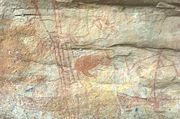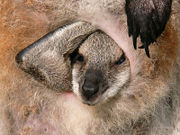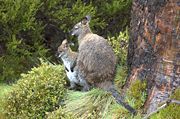Wallaby
2008/9 Schools Wikipedia Selection. Related subjects: Mammals
| Wallabies | ||||||||||||||
|---|---|---|---|---|---|---|---|---|---|---|---|---|---|---|
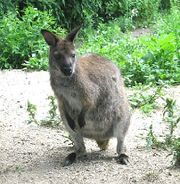 Red-necked Wallaby
|
||||||||||||||
| Scientific classification | ||||||||||||||
|
A wallaby is any of about thirty species of macropod (Family Macropodidae). It is an informal designation generally used for any macropod that is smaller than a kangaroo or wallaroo that has not been given some other name.
Very small forest-dwelling wallabies are known as pademelons (genus Thylogale) and dorcopsises (genera Dorcopsis and Dorcopsulus). The name wallaby comes from the Eora Aboriginal tribe who were the original inhabitants of the Sydney area. Young wallabies are known as " joeys", like many other marsupials.
Range and habitat
Wallabies are widely distributed across Australia, particularly in more remote, heavily timbered, or rugged areas, less so on the great semi-arid plains that are better suited to the larger, leaner, and more fleet-footed kangaroos. They are widespread in New Zealand, where they are often hunted. There are also a few populations of wallabies in the British Isles all having escaped from zoos, the largest of which can be found on the Isle of Man where there is a breeding colony of around 80.
Classification
Wallabies are not a distinct biological group. Nevertheless they fall into several broad categories. Typical wallabies of the Macropus genus, like the Agile Wallaby (Macropus agilis), and the Red-necked Wallaby (Macropus rufogriseus) are most closely related to the kangaroos and wallaroos and, size aside, look very similar. These are the ones most frequently seen, particularly in the southern states.
Rock-wallabies (genus Petrogale), rather like the goats of the northern hemisphere, specialise in rugged terrain and have modified feet designed to grip rock with skin friction rather than dig into soil with large claws. There are at least fifteen species and the relationship between several of them is poorly understood. Several are endangered. Captive rock wallaby breeding programs like the one at Healesville Sanctuary have had some success and a small number have recently been released into the wild.
The Banded Hare-wallaby (Lagostrophus fasciatus) is thought to be the last remaining member of the once-numerous subfamily Sthenurinae, and although once common across southern Australia, is now restricted to two islands off the Western Australian coast which are free of introduced predators. It is not as closely related to the other hare wallabies (genus Lagorchestes) as the hare wallabies are to the other wallabies.
New Guinea, which was until fairly recent geological times part of mainland Australia, has at least five species of wallaby.
Feral populations
Wallabies are an introduced species in New Zealand, where they are considered a pest. A program to reintroduce them to Australia has met with limited success.
Additionally, a small feral population of wallabies is known to exist in Hawai'i, in the upper regions of Kalihi Valley of the island of Oahu. This colony arose from an escape of zoo specimens of Brush-tailed Rock Wallaby (Petrogale penicillata) in 1916.
A number of wallaby breeding colonies in other parts of the world have been established at times in the past, but only one proved viable. The two principal populations were those of the island of Inchconnachan in Loch Lomond, Scotland and in the Peak District of England. The Peak District population was established in around 1940 by five escapees from a local zoo and lasted until at least 1993. At its peak the population numbered around fifty individuals. The Loch Lomond population was deliberately established in 1975 and unmanaged has achieved a viable population of around 28. Restricted to the island of Inchconnachan there are occasional escapes to the mainland when the loch freezes over. Other populations in the United Kingdom that for some periods bred successfully included one near Teignmouth, Devon, another in the Ashdown Forest, East Sussex and one on the island of Bute and Lundy.
There is also a small population on Lambay Island off the east coast of Ireland. This group was introduced by Dublin Zoo after a sudden population explosion in the mid 1980s.
Species
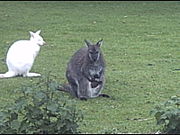
As mentioned above, the term wallaby is ill-defined and can mean just about any macropod of moderate size. In consequence, the listing below is arbitrary and taken from the complete list of macropods.
- Banded Hare-wallaby, Lagostrophus fasciatus
- Brown Dorcopsis, Dorcopsis muelleri
- White-striped Dorcopsis, Dorcopsis hageni
- Black Dorcopsis, Dorcopsis atrata
- Gray Dorcopsis, Dorcopsis luctuosa
- Small Dorcopsis, Dorcopsulus vanheurni
- Macleay's Dorcopsis, Dorcopsulus macleayi
- Lake Mackay Hare-wallaby, Lagorchestes asomatus
- Spectacled Hare-wallaby, Lagorchestes conspicillatus
- Rufous Hare-wallaby, Lagorchestes hirsutus
- Eastern Hare-wallaby, Lagorchestes leporides
- Agile Wallaby, Macropus agilis
- Black-striped Wallaby, Macropus dorsalis
- Tammar Wallaby, Macropus eugenii
- Toolache Wallaby, Macropus greyii (extinct)
- Western Brush Wallaby, Macropus irma
- Parma Wallaby: Macropus parma (rediscovered, thought extinct for 100 years)
- Pretty-faced Wallaby: Macropus parryi
- Red-necked Wallaby: Macropus rufogriseus
- Bridled Nail-tail Wallaby, Onychogalea fraenata
- Crescent Nail-tail Wallaby, Onychogalea lunata (extinct)
- Northern Nail-tail Wallaby, Onychogalea unguifera
- Short-eared Rock-wallaby, Petrogale brachyotis
- Monjon, Petrogale burbidgei
- Nabarlek, Petrogale concinna
- Proserpine Rock-wallaby, Petrogale persephone
- Rothschild's Rock-wallaby, Petrogale rothschildi
- Yellow-footed Rock-wallaby, Petrogale xanthopus
- Allied Rock-wallaby, Petrogale assimilis
- Cape York Rock-wallaby, Petrogale coenensis
- Godman's Rock-wallaby, Petrogale godmani
- Herbert's Rock-wallaby, Petrogale herberti
- Unadorned Rock-wallaby, Petrogale inornata
- Black-flanked Rock-wallaby, Petrogale lateralis
- Mareeba Rock-wallaby, Petrogale mareeba
- Brush-tailed Rock-wallaby, Petrogale penicillata
- Purple-necked Rock-wallaby, Petrogale purpureicollis
- Mt. Claro Rock-wallaby, Petrogale sharmani
- Tasmanian Pademelon, Thylogale billardierii
- Brown's Pademelon, Thylogale browni
- Dusky Pademelon, Thylogale brunii
- Calaby's Pademelon, Thylogale calabyi
- Mountain Pademelon, Thylogale lanatus
- Red-legged Pademelon, Thylogale stigmatica
- Red-necked Pademelon, Thylogale thetis
- Swamp Wallaby or Black Wallaby, Wallabia bicolor
Fictional wallabies
- Rocko from Rocko's Modern Life.
- Wallaby, or "Warabi", a stuffed Wallaby doll from the Kiyohiko Azuma manga of the same name.
